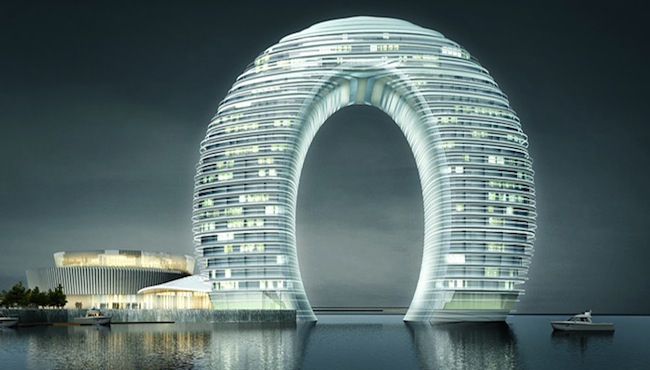The Emporis Skyscraper Award, the world's most renowned prize for skyscrapers, this year goes to London.
The tallest building in Western Europe, The Shard, was chosen by an international panel of experts from more than 300 skyscrapers of at least 100 meters' height and which were completed during the previous calendar year.
The award, given by Emporis, the international provider of building data, is now into its 14th year.
The 306-meter-tall winning building, designed by the architect Renzo Piano, won over the jury thanks to its unique glass fragment-shaped form and its sophisticated architectural implementation.
"Construction of The Shard was complicated by the particularly tight site and therefore needed innovative planning. This makes the result all the more impressive: a skyscraper that is recognized immediately and which is already considered London's new emblem," stated the expert jury in explaining its decision.
Second place in the voting went to DC Tower 1 by Dominique Perrault Architecture. The 250-meter-tall Viennese skyscraper particularly stands out for the contrasting way in which its facade is treated: Three mirror-smooth sides are broken by a craggy, jagged fourth that gives the building a strength of expression and sense of solidity, despite its slim stature.
DC Tower 1 also impressed due to its comprehensive sustainability concept, including photovoltaics to generate energy, local plants with low water requirements in the green areas of the building, and electric car chargers to save on CO² emissions.
The third-placed project also breaks with the standards of conventional high-rise architecture and thus adds to the great variety of forms and shapes that characterizes this year's Emporis Skyscraper Award. Located on Lake Tai, the Sheraton Huzhou Hot Spring Resort, conceived by last year's winning architects MAD, is a 102-meter-tall hotel whose shape evokes a gigantic ring. Its daring design is further accentuated by its illumination at night, which creates imposing reflections of the building in the lake.
After the award had gone in the last two years to Absolute World Towers in Canada and New York by Gehry at Eight Spruce Street in the U.S., no North American skyscraper is to be found in the Top Ten on this occasion. By contrast, the Emporis Skyscraper Award winners' list contains a total of five European projects – the last time so many were represented was six years ago. With The Shard, this is the fifth time the coveted architecture prize has gone to Europe.
About Emporis
Emporis is a leading database of information about building and construction projects, based in Germany. For over a decade Emporis has helped companies, organizations and individuals stay informed about the building industry. The Emporis Skyscraper Award is the world’s most renowned prize for high-rise architecture.
About the Award
The Emporis Skyscraper Award has been given since 2000. The jury is formed of architecture experts from all over the world, who judge nominated buildings according to aesthetic and functional design criteria. Previous winners include Absolute World Towers (2012), New York by Gehry at 8 Spruce Street (New York City, 2011) and Hotel Porta Fira (L’Hospitalet de Llobregat, 2010).
Related Stories
| Nov 17, 2011
Hollister Construction Services renovating bank in Union City, N.J.
Project is part of a series of ground-up construction and renovation assignments.
| Nov 16, 2011
Project completion of BRAC 132, Office of the Chief Army Reserve Building, Ft. Belvoir, Va.
This fast-tracked, design-build project consists of a three-story, 88,470 sf administrative command building housing approximately 430 employees.
| Nov 16, 2011
Architecture Billings Index moves upward
The Architecture Billings Index climbed nearly three points in October.
| Nov 16, 2011
CRSI recommends return to inch-pound markings
The intention of this resolution is for all new rollings of reinforcing steel products to be marked with inch-pound bar markings no later than January 1st, 2014.
| Nov 16, 2011
John Patelski joins Ghafari as executive vice president
As executive vice president, Patelski will be responsible for expanding the firm’s services in new strategic markets.
| Nov 15, 2011
Struggling economy demands construction industry embrace enterprise-wide risk management
In today’s business environment of high supply and limited demand, it has become especially vital for organizations in the construction sector to effectively manage risk.
| Nov 15, 2011
Suffolk Construction breaks ground on the Victor housing development in Boston
Project team to manage construction of $92 million, 377,000 square-foot residential tower.
| Nov 15, 2011
Miller joins Perkins Eastman as regional manager, Middle East and Northern Africa
Miller joins Perkins Eastman with more than 48 years of experience in architecture, design management, and construction administration for planning and infrastructure.
| Nov 14, 2011
Summit Design+Build selected at GC for new Office Concepts headquarters
The new headquarters will include 17,000 sf of office space and 15,000 sf of warehouse and feature 24 ft ceilings, an open floor plan, two conference rooms and one training room and will feature sustainable finishes throughout.
















